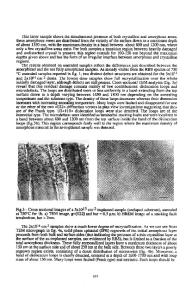Amorphization and Recrystallization in MeV Ion Implanted InP Crystals
- PDF / 1,552,607 Bytes
- 7 Pages / 420.48 x 639 pts Page_size
- 97 Downloads / 338 Views
AMORPHIZATION AND RECRYSTALLIZATION IN MeV ION IMPLANTED InP CRYSTALSt Fulin Xiong, C. W. Nieh, D. N. Jamieson, T. Vreeland, Jr., and T. A. Tombrello Materials Research Group, California Institute of Technology, Pasadena, California 91125. ABSTRACT A comprehensive study of MeV- 1 5N-ion-implanted InP by a variety of analytical techniques has revealed the physical processes involved in MeV ion implantation into III-V compound semiconductors as well as the influence of post-implantation annealing. It provides a coherent picture of implant distribution, structural transition, crystalline damage, and lattice strain in InP crystals induced by ion implantation and thermal annealing. The experimental results from the different measurements are summarized in this report. Mechanisms of amorphization by implantation and recrystallization through annealing in MeV-ion-implanted InP are proposed and discussed in light of the results obtained. INTRODUCTION Currently there is a considerable interest in MeV ion implantation into III-V compound semiconductors due to its potential to form buried heterojunction layers and modify electrical and optical properties as well as its use in 3-dimensional device processing. However, the extension of the ion implantation energy to the MeV range has raised many interesting questions about the mechanism of radiation-induced damage and its relation to implant distribution in crystalline solids. An understanding of the associated physical processes involved in MeV ion implantation as well as in the subsequent annealing is crucial before it can be universally applied. This emphasis is strongly modivated by the need of the microelectronic industry for new integrated circuit processing techniques and noval electronic device structure as well as optical laser and microwave devices. Work on GaAs can be found in many reports['-3], but there are few reports on InP[4-6]; however, most of the work concentrated on the use of keV ions. Last year we reported[6] the radiation-induced lattice contraction in MeV ion implanted InP through the x-ray rocking curve studying. The effect observed was opposite 2 to what was observed in MeV-ion-implanted GaAs[ ]. Further work has been carried out with MeV-N+-ion implantation into InP crystals to investigate the physical processes involved, thus to obtain a better understanding of the mechanisms of amorphization and recrystallization that occures in MeV ion implantation and post-implantation annealing of III-V compound semiconductors. Subsequent characterization by a variety of analytical techniques has been undertaken. Nuclear resonant reaction analysis (NRRA) was employed to profile the implant depth distribution. The x-ray rocking curve technique (XRC) was utilized to measure the radiation-induced lattice strain and damage. Channeling Rutherford backscattering spectrometry (CRBS) was conducted to profile the implantation-induced crystal damage and defect distribution. Cross sectional and high resolution transmission electron microscopy (XTEM and HRTEM) were performed
Data Loading...









